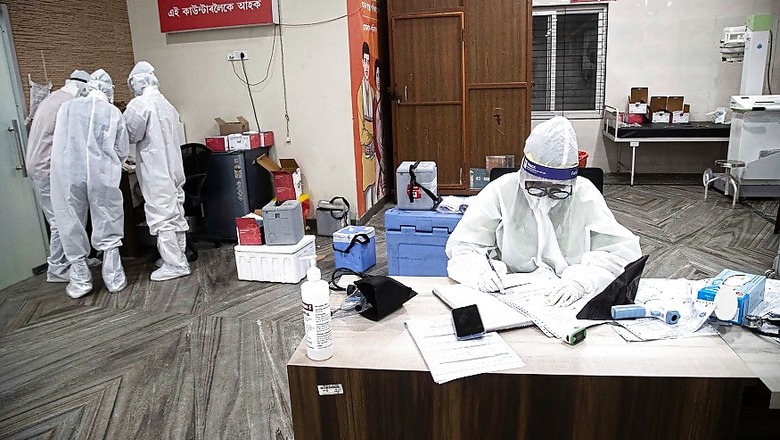
views
CK Mishra, chairman of the Empowered Group on availability of hospital isolation facilities, quarantine facilities and healthcare infrastructure set up by the government, who is also the environment secretary, speaks with CNN-News18 on the coronavirus pandemic and the ensuing lockdown.
What did India gain from the nation-wide lockdown?
There are three critical things we understood. First, the lockdown gave people and the government to prepare infrastructure and strategy. The time and ability to cut lower transmission and we managed to avert many deaths which would have not been possible if the lockdown had not been there.
What position was India in two months ago as far as healthcare infrastructure for Covid-19 is concerned?
We prepared dedicated COVID-19 hospitals, and in layers. First layer you have ICU and ventilators, second layer was oxygen layer and third is isolation beds. We have ramped up ICU facilities to the extent that we can say we have 1.5 lakh beds. With the capacity to increase if there is pressure on hospitals. Fortunately our hospitals as of now are not overwhelmed.
A large number of people are recuperating at home now.
That is correct. People are getting infected and getting all right. Globally 30% of patients need hospitalisation. In india 6%-7% actually need hospitalisation. That should be reassuring to people.
I understand that we have our physical infrastructure in place - but manpower? Do we have enough people and staff trained to handle a pandemic?
Yes, this continues to be a concern because that is something we can’t stretch beyond a point. But in this period of lockdown, we have managed to conduct several courses to train them. Our ICU management is better. Our manpower is trained. It may not be the best, but we have enough to take care that is going to come.
What are the challenges that you are anticipating?
Daywise increase in cases. The biggest challenge now is to ensure our deaths rate remain low. We need to save lives. People will get infected, they will get cured, but deaths we have to keep under control.
In case of an eventuality, can you take over private hospitals?
Take over may not be the correct word. We need the private sector to join the public sector. We would seek the private sector to come in and join the public sector.
They are overcharging. How will they do it?
The state governments are acting on those complaints.
We ramped up from 1 to 600 labs. How?
We had no labs. Testing facilities were limited. We didn’t create labs. Over two months we kept on finding new sources where testing can be done. Labs which were doing research were brought in. Some labs that were not complete were completed and brought in. Government medical colleges were made to put up labs. We brought in private players. This infrastructure creation is crucial to healthcare system in India even in the future.
Migrant workers moving back home will lead to infection in rural India.
We have seen a rise in infection in eastern India and now our focus will be there. If levels increase, we have to bring in microbiologists and virologists are not available there. There are no medical colleges. Using machines to test samples for TB will be used there. Trunat are being used there. Private labs are being hand held. None of the states are overwhelmed with excessive samples.
The number of migrant workers who have tested positive -- could you tell us how many?
The positivity rate in some of the states where migrants are moving is as higher than the national level. The numbers tested so far are not huge.
What about the pressure on the rural healthcare system once cases increase?
So far the disease is showing a rise in urban India where density of population is much more. Our hospitalisation requirement is less. A district is a unit so that rural areas get factored in. Rural India has not been impacted. District as a unit will serve rural areas. Private players are being roped in.
Will there be a peak in infection?
We need to watch out for next two months when cases will increase.
And people moving around will increase it further.
Other things as well. More surveillance - more testing. People moving around.
Our case positivity ratio has gone up significantly.
We are at 5% now. This hasn’t gone up significantly. It is because of people moving around.
If you compare yourself with other countries in terms of cases, why should you not compare yourself in terms of testing they are doing which is leading to more cases being diagnosed?
We are a country of 1.3 billion population. We can’t afford or should not be testing everyone. Testing is response to a challenge. As challenges change, our response changes. Earlier we were testing 4,000 to 5,000 samples. Now we are testing more. We can even do 1.50 lakh. It’s a calibrated effort and a focused testing strategy.
What sort of surveillance testing are we doing given that we had a bad episode with serological tests?
Elisa is a good reliable alternative to serological tests.
What is the government doing today to ensure death rate is stable and slips further?
We have been constantly trying to social message. We have to keep them indoors as much as we can. We have a back-up medical facility in case of infection in senior citizens and those with co-morbidities.

















Comments
0 comment